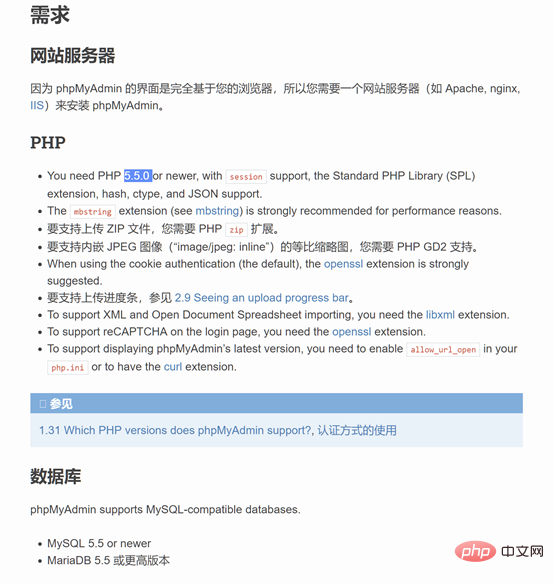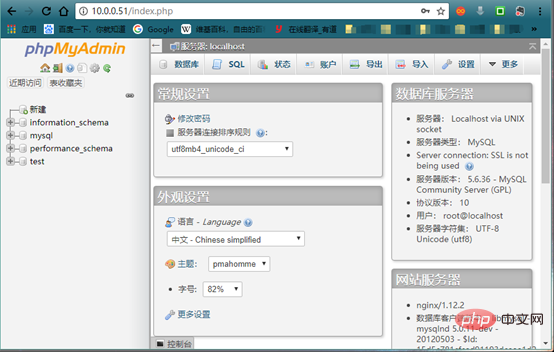 Database
Database
 phpMyAdmin
phpMyAdmin
 Detailed explanation of how to build a multi-database server with phpMyAdmin
Detailed explanation of how to build a multi-database server with phpMyAdmin
Detailed explanation of how to build a multi-database server with phpMyAdmin
This article will use the phpmyadmin tutorial column to introduce you to phpMyAdmin's method of building and managing multiple database servers. I hope it will be helpful to friends in need!
phpMyAdmin builds and manages multiple database servers
Environment description:
系统版本 CentOS 6.9 x86_64 软件版本 nginx-1.12.2 php-5.5.38 phpMyAdmin 4.8.0.1
1. Introduction to phpMyAdmin
phpMyAdmin is a PHP-based, Web-based -Base mode is a MySQL database management tool built on the website host, allowing administrators to use the Web interface to manage the MySQL database. This web interface can be a better way to input complex SQL syntax in a simple way, especially when it comes to importing and exporting large amounts of data. One of the greater advantages is that phpMyAdmin is executed on the web server like other PHP programs, but you can use the HTML pages generated by these programs anywhere, that is, to remotely manage the MySQL database, and easily create, modify, and delete Databases and data tables. You can also use phpMyAdmin to create commonly used PHP syntax to facilitate the correctness of SQL syntax required when writing web pages.
Official website: https://www.phpmyadmin.net
2. Environmental requirements for installing phpMyAdmin

3. Steps
3.1. Compile and install nginx and php. You can refer to the previous blog post. I will not go into details here. However, based on the environmental requirements of phpMyAdmin, the compilation parameters used when compiling php are:
./configure --prefix=/application/php5.5.38 --with-jpeg-dir=/usr/lib64 --with-freetype-dir=/usr/lib64/ --with-curl --enable-fpm --enable-mbstring --with-gd --with-fpm-user=nginx --with-fpm-group=nginx --with-mysqli=mysqlnd --with-mysql-sock=/tmp/mysql.sock --with-openssl --enable-zip
3.2. Configure phpMyAdmin
Put the downloaded phpmyadmin source code package into the nginx site root directory, that is, the html directory, unzip and modify the nginx configuration file, and rename the default phpMyAdmin configuration file cp config.sample.inc.php config.inc. php
3.3. Build the database and perform database creation authorization (refer to the previous blog post)
3.4. Browser access login

4 , Configure phpMyAdmin to manage multiple database servers
Take 10.0.0.51 and 10.0.0.52 as examples
4.1 Install mysql on 10.0.0.52
Set password and log in to mysql
[root@db02 mysql]# mysql -uroot -p123456
Authorize the database to 10.0.0.51
mysql> grant all on *.* to root@'10.0.0.51' identified by '123456';
4.2 Configure db01 with phpMyAdmin installed
vim /application/nginx/html/phpMyAdmin-4.8.0.1-all-languages/config.inc.php 复制粘贴并修改 $i++; /* Authentication type */ $cfg['Servers'][$i]['auth_type'] = 'cookie'; /* Server parameters */ $cfg['Servers'][$i]['host'] = '10.0.0.52'; $cfg['Servers'][$i]['compress'] = false; $cfg['Servers'][$i]['AllowNoPassword'] = false;
Refresh the page to log in to the 10.0.0.52 database.
The above is the detailed content of Detailed explanation of how to build a multi-database server with phpMyAdmin. For more information, please follow other related articles on the PHP Chinese website!

Hot AI Tools

Undresser.AI Undress
AI-powered app for creating realistic nude photos

AI Clothes Remover
Online AI tool for removing clothes from photos.

Undress AI Tool
Undress images for free

Clothoff.io
AI clothes remover

AI Hentai Generator
Generate AI Hentai for free.

Hot Article

Hot Tools

Notepad++7.3.1
Easy-to-use and free code editor

SublimeText3 Chinese version
Chinese version, very easy to use

Zend Studio 13.0.1
Powerful PHP integrated development environment

Dreamweaver CS6
Visual web development tools

SublimeText3 Mac version
God-level code editing software (SublimeText3)

Hot Topics
 1378
1378
 52
52
 How to set primary key in phpmyadmin
Apr 07, 2024 pm 02:54 PM
How to set primary key in phpmyadmin
Apr 07, 2024 pm 02:54 PM
The primary key of a table is one or more columns that uniquely identify each record in the table. Here are the steps to set a primary key: Log in to phpMyAdmin. Select database and table. Check the column you want to use as the primary key. Click "Save Changes". Primary keys provide data integrity, lookup speed, and relationship modeling benefits.
 How to add foreign keys in phpmyadmin
Apr 07, 2024 pm 02:36 PM
How to add foreign keys in phpmyadmin
Apr 07, 2024 pm 02:36 PM
Adding a foreign key in phpMyAdmin can be achieved by following these steps: Select the parent table that contains the foreign key. Edit the parent table structure and add new columns in "Columns". Enable foreign key constraints and select the referencing table and key. Set update/delete operations. save Changes.
 Where is the phpmyadmin log?
Apr 07, 2024 pm 12:57 PM
Where is the phpmyadmin log?
Apr 07, 2024 pm 12:57 PM
Default location for PHPMyAdmin log files: Linux/Unix/macOS:/var/log/phpmyadminWindows: C:\xampp\phpMyAdmin\logs\ Log file purpose: Troubleshooting Audit Security
 Where does the wordpress database exist?
Apr 15, 2024 pm 10:39 PM
Where does the wordpress database exist?
Apr 15, 2024 pm 10:39 PM
The WordPress database is housed in a MySQL database that stores all website data and can be accessed through your hosting provider’s dashboard, FTP, or phpMyAdmin. The database name is related to the website URL or username, and access requires the use of database credentials, including name, username, password, and hostname, which are typically stored in the "wp-config.php" file.
 What is the password for the phpmyadmin account?
Apr 07, 2024 pm 01:09 PM
What is the password for the phpmyadmin account?
Apr 07, 2024 pm 01:09 PM
The default username and password for PHPMyAdmin are root and empty. For security reasons, it is recommended to change the default password. Method to change password: 1. Log in to PHPMyAdmin; 2. Select "privileges"; 3. Enter the new password and save it. When you forget your password, you can reset it by stopping the MySQL service and editing the configuration file: 1. Add the skip-grant-tables line; 2. Log in to the MySQL command line and reset the root password; 3. Refresh the permission table; 4. Delete skip-grant-tables line, restart the MySQL service.
 How to delete data table in phpmyadmin
Apr 07, 2024 pm 03:00 PM
How to delete data table in phpmyadmin
Apr 07, 2024 pm 03:00 PM
Steps to delete a data table in phpMyAdmin: Select the database and data table; click the "Action" tab; select the "Delete" option; confirm and perform the deletion operation.
 why phpmyadmin access denied
Apr 07, 2024 pm 01:03 PM
why phpmyadmin access denied
Apr 07, 2024 pm 01:03 PM
Reasons and solutions for access denied by phpMyAdmin: Authentication failed: Check whether the username and password are correct. Server configuration error: adjust firewall settings and check whether the database port is correct. Permissions issue: Granting users access to the database. Session timeout: Refresh the browser page and reconnect. phpMyAdmin configuration error: Check the configuration file and file permissions to make sure the required Apache modules are enabled. Server issue: Wait for a while and try again or contact your hosting provider.
 What kind of vulnerability does the phpmyadmin vulnerability belong to?
Apr 07, 2024 pm 01:36 PM
What kind of vulnerability does the phpmyadmin vulnerability belong to?
Apr 07, 2024 pm 01:36 PM
phpMyAdmin is susceptible to multiple vulnerabilities, including: 1. SQL injection vulnerability; 2. Cross-site scripting (XSS) vulnerability; 3. Remote code execution (RCE) vulnerability; 4. Local file inclusion (LFI) vulnerability; 5. Information disclosure Vulnerability; 6. Privilege escalation vulnerability.



